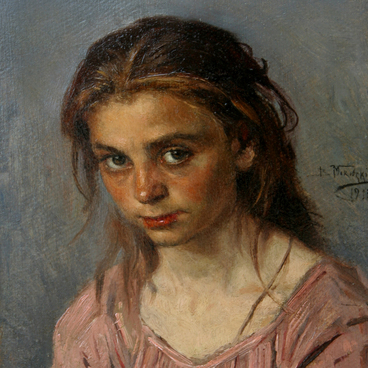The most significant achievements of the Russian realism in the art of the second half of the 19th century are associated with creative work of Ilya Efimovich Repin (1844–1930). A perfect example of the genre in the Museum collection is a sketch of the head of the exiled for the famous painting They Did Not Expect Him. The artist was working on the painting for four years starting from 1884. Now the painting is kept in the Collection of the State Tretyakov Gallery.
In the period of time started in late 1870s, an important subject in Repin’s genre paintings became moments of life of a typical Russian revolutionary. His large-scale work They Did Not Expect Him reveals his thoughts of the destiny of exiled. One should not forget that the action takes place during social and political changes in Russia that followed after the defeat of Populism (“Narodnichestvo”).
Former activists of resistance to the tsarist regime started to return from their exiles. The subject of the picture They Did Not Expect Him is based on exactly such a moment. In addition to the complex genre context that includes the situation itself (meeting of the revolutionary with his close relatives and the family reaction to his return), the painter had to capture psychological moments. Will the family be able to understand and justify the sacrifice that the returned man had put on the altar of his ideas?
Ilya Repin wanted to capture the character of a revolutionary who had spent many years away from his relatives, his tragedy and psychological state. His commitment to that is confirmed by sketches of the head of the exiled, where the most significant role is played by the facial expression of the latter.
As of today, only two sketches of the revolutionary’s head are known. One of them is kept in the State Russian Museum of St. Petersburg, and the other one, in the Bashkortostan State M.V. Nesterov Art Museum. Experts believe that it is the ‘Bashkir’ version that was painted earlier. We see conviction and strength in the eyes of the character. The first impression is confirmed by the solid set of the head and the facial expression.
In the second sketch, the exiled reminds of the Prodigal Son by Rembrandt: undernourished, tired, with dark shadows under the eyes. This increases the value of the ‘Bashkir’ painting. Interestingly enough, both pictures, although differing in psychological representation of the main character, bear traces of artistic independence. The painter created a portrait with elements of the drama filled with spiritual tension, where the character’s disappointment is blended with his plans for the future.
Since 1913, Repin’s sketch The Head of the Exiled has been kept in the Museum collection, where to it was donated as part of a gift by Mikhail Vasilyevich Nesterov.
In the period of time started in late 1870s, an important subject in Repin’s genre paintings became moments of life of a typical Russian revolutionary. His large-scale work They Did Not Expect Him reveals his thoughts of the destiny of exiled. One should not forget that the action takes place during social and political changes in Russia that followed after the defeat of Populism (“Narodnichestvo”).
Former activists of resistance to the tsarist regime started to return from their exiles. The subject of the picture They Did Not Expect Him is based on exactly such a moment. In addition to the complex genre context that includes the situation itself (meeting of the revolutionary with his close relatives and the family reaction to his return), the painter had to capture psychological moments. Will the family be able to understand and justify the sacrifice that the returned man had put on the altar of his ideas?
Ilya Repin wanted to capture the character of a revolutionary who had spent many years away from his relatives, his tragedy and psychological state. His commitment to that is confirmed by sketches of the head of the exiled, where the most significant role is played by the facial expression of the latter.
As of today, only two sketches of the revolutionary’s head are known. One of them is kept in the State Russian Museum of St. Petersburg, and the other one, in the Bashkortostan State M.V. Nesterov Art Museum. Experts believe that it is the ‘Bashkir’ version that was painted earlier. We see conviction and strength in the eyes of the character. The first impression is confirmed by the solid set of the head and the facial expression.
In the second sketch, the exiled reminds of the Prodigal Son by Rembrandt: undernourished, tired, with dark shadows under the eyes. This increases the value of the ‘Bashkir’ painting. Interestingly enough, both pictures, although differing in psychological representation of the main character, bear traces of artistic independence. The painter created a portrait with elements of the drama filled with spiritual tension, where the character’s disappointment is blended with his plans for the future.
Since 1913, Repin’s sketch The Head of the Exiled has been kept in the Museum collection, where to it was donated as part of a gift by Mikhail Vasilyevich Nesterov.



